PrimeCables C05132 Charging Station Tear-Down: Organizational Power
Limit Testing
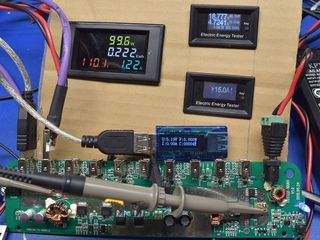
Did the DC-DC converter or AC adapter die? No. Unlike most other USB power supplies, PrimeCable’s station has no trouble meeting its 13.2A total output rating. Its 3.78A/19V AC adapter was still going strong at 4.56A/18.8V by the time my output load reached 15A, exceeding my meter’s rating in the bottom-right.
How high could the AC adapter and station go? I need a current meter capable of handling more than 15A to find out. Both components handily exceeded their specifications. With proper per-port protection, I am perfectly happy with that.
Standby Power
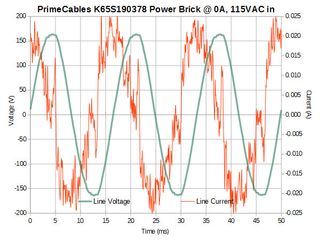
For single-rail "basic voltage" (that’s fancy talk for output voltages greater than 6V) AC power adapters with an output power in excess of 50W to meet Level VI efficiency, they need to draw 200mW or less in standby. PowerCable’s brick easily beats the mark by drawing only 105mW with the station connected but turned off.
Merely turning the station on with no loads attached draws 5.6mA from the brick’s output and increases its input power draw to 293mW, making this the most power-hungry charger in a ready-standby state that I have seen so far, courtesy of its double-conversion design.
Efficiency

This is where the efficiency of double-conversion designs falls apart. While the AC adapter’s ~88% efficiency (I’m giving the brick a generous 2% margin) and the DC-DC converter’s ~93% efficiency are great individually, combining them ultimately yields significantly lower system efficiency than direct conversion to the final voltage, as shown by SilverStone’s UC01.
Did my test setup changes from earlier have any effect on efficiency? Not really: all changes were sub-1%, margin of error stuff.
Peak-to-Peak Output Noise

The C05132’s input filter and DC-DC converter do a good job of isolating the load from its AC adapter's noise. Its output filter also does a great job eliminating the bulk of switching transient noise, even at the highest load I could put on it.
Stay on the Cutting Edge
Join the experts who read Tom's Hardware for the inside track on enthusiast PC tech news — and have for over 25 years. We'll send breaking news and in-depth reviews of CPUs, GPUs, AI, maker hardware and more straight to your inbox.
What is the story for the brick noise peak near 1A? In that light load region, the switching regulators are operating in their pulse frequency modulation range and may have hit the filter components’ resonance frequency or run into situations where the two regulators are chasing each other.
RMS Output Noise
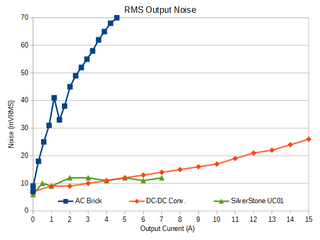
We have a tie in the RMS noise department between SilverStone and PrimeCables, at least as far as the UC01’s operating range is concerned. Noise does double to a still-acceptable 26mV by the time we reach 15A. But we can't really blame the device for getting a little noisier under a 14% overload.
Just as it did on the peak-to-peak noise, input filter resonance at ~1A AC adapter load shows up in the RMS input noise measurement. And, just as before, there is no sign of it having any effect on the DC-DC converter’s output.
Output Voltage Regulation

Voltage regulation against load is also perfectly fine. Do keep in mind that I measured voltage using a separate USB meter on an otherwise unloaded port while applying the load directly on the 5V bus. Under normal circumstances, loads would be connected downstream from the over-current protection chips. This adds ~70mΩ of resistance and reduces the port voltage by ~70mV at 1A. Beyond that, you also have cable losses to consider.
The AC adapter’s linear voltage slope of 640mV per 4.56A tells us that its wiring and connector resistances are at least 140mΩ. They could be significantly higher if the adapter has some degree of cable drop compensation built in, as is quite common in modern regulators designed for corded power adapters.
Short-Circuit Response: 2.4A Ports
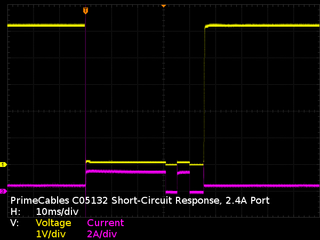
Upon initial short-circuit application, the protection chip limits current to about 1.6A until over-temperature protection kicks in and shuts it down. From there, it turns the output back on whenever its temperature comes down sufficiently. The longer the short-circuit condition lasts, the hotter the circuit board around the chip gets and the longer it takes for the chip to cool down enough to turn on again.
The first time I shorted the port out for a few seconds, I thought I had killed the output; it didn’t turn back on until several seconds later. I shouldn't have been surprised, though. Eight watts is quite a bit of power to dissipate for an SOT-23-5 package.
Short-Circuit Response: 1A Ports
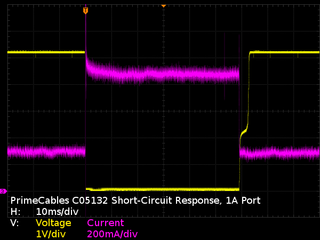
Shortly after the short condition is detected, the 1A ports’ current gets folded back to about 800mA until either the short is removed or the protection circuit trips its thermal limit.
Transient Response
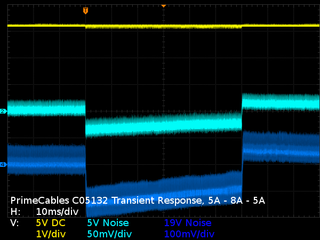
How well does the station’s DC-DC converter handle a 3A load transient? The output dips by about 30mV mainly due to resistance between test points and the DC-DC converter’s output voltage feedback points. There is hardly any sign that the DC-DC converter had to adjust to output load. I see no visible reaction upon application and only a slight "knee" when the extra load is removed. If you look very closely, you’ll notice that the voltage goes maybe 10mV above what it settles to shortly thereafter. Overshoot and undershoot are effectively nonexistent.
That’s the cleanest transient response yet.
AC Adapter Isolation Withstand Test
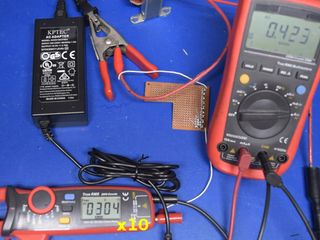
Does the AC adapter actually pass my critical isolation withstand test? As you should expect from any adapter with legitimate UL and TUV marks, it does, only leaking 520µA at 3500VAC. With a leakage impedance in excess of 7MΩ, we’re talking less than 400pF worth of capacitance. That likely means there are no Y-capacitors (typically 1-1.5nF) in there, only parasitic coupling between transformer windings through insulation.
Are you disappointed that I didn’t open the AC adapter? If enough readers ask for it, I could make this happen, though opening them is frequently more trouble than it is worth.

VESA introduces DisplayPort 2.1a standard, providing higher resolution and refresh rate combos and doubling cable length limit

Nvidia's problems with melting GPU connectors intensify — CableMod issues safety recall of 16-pin power adapters for Nvidia GPUs due to overheating and melting, advises disconnecting them immediately
-
andrewpong Could you look at anker 5 port chargers, especially those with PowerIQ and QuickCharge features?Reply -
Daniel Sauvageau Reply
As far as I know at the moment, Power IQ appears to be Anker's trademark for using device identification chips, quite possibly the same CX1901/2901 and equivalents everyone else use.20905501 said:Could you look at anker 5 port chargers, especially those with PowerIQ and QuickCharge features?
As for QuickCharge, PassMark sent me one of its USB-PD testers and I was told they MIGHT implement QuickCharge support in the future. Right now, I'm waiting to hear more about how likely that is to happen while I decide how I am going to use the tester in the future, which currently means pestering PassMark with bug reports and feature requests to enhance its versatility.
I did receive three adapters with QC 3.0 support and a plain 5-ports adapter, two from Aukey, two from Anker courtesy from Roger. I could do tear-downs and test them as regular 5V adapters for now, then revisit them once I have something to emulate the protocol with. I could certainly start that batch from the 5-ports non-QC one and pit it against SilverStone's UC01.
At the moment, I have two more cube-style generic adapters in the publication pipeline and I'm partly done putting together a third one about a house-brand unit. (Spoiler: that third one is disappointing for unusual reasons. Though the 'unusual' could simply be because I am breaking into a new form-factor category - at least for me - on that one.) -
andrewmtl This is awesome for the party, if you host a party that is around 10 ppl, then you will love this little device, by the way, I believe that also had 2-3 faster charging port!Reply -
Daniel Sauvageau Reply
As I pointed out in the tear-down, two ports have dedicated 2.4A (2.6-2.65A measured) output each and a second pair is sharing a single 2.4A e-fuse, each pair using a CH2311 charger ID chip. The rest all do 1.4A with various resistor ID schemes.20938782 said:This is awesome for the party, if you host a party that is around 10 ppl, then you will love this little device, by the way, I believe that also had 2-3 faster charging port!
For offices, parties and mobile devices/gadgetry hoarders where function and convenience far outweigh efficiency, this sort of device can become a necessity.
Most Popular


